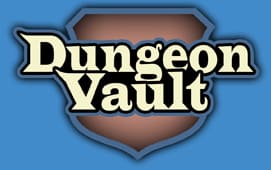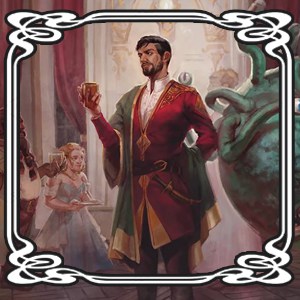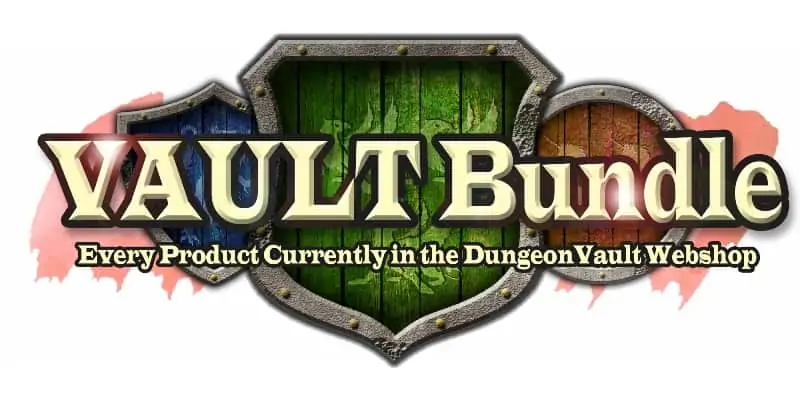
In Dungeons and Dragons most of the game mechanics are oriented towards combat. But D&D offers a wide assortment of non-combat challenges to add variety to your game. In fact, the Dungeon Master Guide mentions three pillars of adventuring: The first is combat. But the second and third are social interaction and exploration. You could say that in the average game about two thirds of D&D is NOT about combat.
There’s a ton of classic non-combat challenges that are often underused. As a DM I keep a list of different types of challenges just so that players never encounter the same type of challenge in a row. So let’s take a look at 9 classic non-combat challenges that are sure winners.
1. Non-combat Riddle Challenges
Riddles are a staple of D&D. But not all players like them. And with good reason. A badly designed riddle can grind your game to a halt fast. Remember Gandalf sitting in front of the Doors of Moria trying to solve the Elven riddle; speak ‘friend’ and enter? That works great in a novel. But for players being stuck is a horrible gaming experience. And even if players solve the riddle, the answer is often so vague that a number of solutions will do.
As a game designer these types of problems bother me. You want your players to have that classical riddle solving experience without the frustration of being stuck or not arriving at a clear answer. So I designed a type of riddle that works better with D&D.
For example:
The solution to this riddle is ‘Sunflower‘. (Select the previous text to read it.)
So how does it work? Two cryptic words form an expression or combined word. Players make two lists of possible synonyms and look for combinations that make sense. For instance:
| Sack & | Tabacco-burner |
| Bag | Cigarette |
| Carryall | Cigar |
| Purse | Pipe |
With the two lists they start making combinations to see what would make sense. They could combine ‘Purse’ and ‘Cigar’ but ‘Pursecigar’ isn’t a word. There’s only one combination that does make sense.
In this example, only ‘bag’ and ‘pipe’ make up the combined word ‘bagpipe’.
So even though single cryptic meanings of words are very vague, this riddle offers a clear process to solving it and gives you one very specific possible solution. If you don’t want to come up with these riddles yourself, I’ve created a Deck of 101 Riddles in printable and virtual tabletop format.
2. Non-combat Travel and Maze Challenges
Travelling from one place to the next can be a fun non-combat challenge in its own right. A simple way to do that is to put obstacles in players’ path. And what better obstacle than a maze without walls?
Confused? Think of all the wilderness areas that Frodo and Sam travelled through on their way to Mordor. They lost their way numerous times. The wilderness was effectively a maze but it didn’t have walls.
So how do we make that type of non-combat experience fun in D&D?
Just like riddles, mazes are a staple of D&D and similarly they suffer from some game design problems. Just giving players a map of a maze doesn’t challenge them. But what if you don’t give them a map?
If you only describe areas, players must use the information to draw out their own map. I’ve created a free sample D&D maze you can use (scroll halfway down the article). Feel free to change the descriptions to match your adventure.
3. Non-combat Puzzles Challenges
I have a passion for creating D&D puzzles. Here at DungeonVault we have the world’s largest collection of illustrated puzzles for D&D for you to choose from.
If instead, you wish to create D&D puzzles yourself here’s a complete guide I wrote on how to make a D&D puzzle. It also explains how to design puzzles that challenge both the players AND their characters and how to not get stuck. And you can find a survey about which puzzles players like best here.
So how can you use D&D puzzles in your game?
There’s a ton of different ways to use puzzles. The most obvious one is sticking a puzzle on a door. Players must solve the puzzle to continue on their path. But puzzles are small rule systems in and of themselves. And you can use them to create a wide variety of non-combat challenges. To illustrate what I mean, let’s look at the next challenge.
4. Non-combat Item Creation Challenges
Players love creating their own magical items. And collecting the ingredients – or finding ingredients as treasure – to then create an item is much more rewarding than just finding a magic sword. But the D&D system for creating magic items is meagre at best.
D&D potion puzzles is a complete system for creating magical items in D&D. Don’t let the name ‘potion’ fool you. Players can also create perfumes, inks, washes, wines, oils, dyes, and polishes.
And when you think about it, every magic item in the Dungeon Masters Guide uses some type of liquid in their creation process. Scrolls need magic inks, swords are tempered in magic water, Robes are dyed with magic dyes and so on.
So for our magic item creation system creating liquids is perfect. With potion puzzles players collect magical plants first and must then discover the recipe and prepare the potion. And the more powerful the magic item, the more difficult ingredients and recipes are to obtain.
5. Non-combat Political Challenges
Doing politics in D&D is another non-combat challenge that is notoriously hard to do well. Here’s why:
First, there are often too many factions the keep track off. And then there are complicated relationships between each of those faction that also evolve over time. Without a visual system to keep track of everything players often forget about all those details.
If five sessions ago the DM mentioned that House Barduc hates House Ferio because of a trade disagreement most players won’t remember. Yes, clever players take notes but in my experience they have a hard time keeping track of everything.
Second, with all these political developments happening around the players it is very hard to keep them at the heart of the story. Even in politics you want players to have agency. Always keep them in the eye of the storm.
But fear not. I’ve designed a complete system for running politics in D&D that avoids these pitfalls. You can read about the rules of D&D politics here.
In short, the system offers a visual way to lay out political situations so players can see hundreds of political relationships in the blink of an eye. And once they make a decision to change the balance of political power, you can use action packed adventures to make that happen.
6. Non-combat Trap Challenges
Traps – while dealing damage – are essentially non-combat challenges. The problem with most traditional traps is that they are save or die experiences. While dying is a part of the game, players should have a fair chance of using their wits to try and beat traps.
A lot of players don’t enjoy traps for this very reason. Sure, they want their dungeons to be dangerous, but they also want a fair chance. And traps are about as unfair as it gets. An example:
“Twig the Tree-elf skips nimbly along a hallway and misses his perception check, having eaten one lembas to many, his weight triggers a pressure plate and a fireball erupts. Twig manages to avoid halve the damage, but it’s not enough to save him.”
And just like that it’s over. The problem with this scenario is that Twig didn’t get to CHOOSE anything. His fate was sealed when he ate that lembas. Poor Twig. But it doesn’t have to be that way.
In order to create a better trap DMs need to slow things down. Yes, a trap can still spring suddenly – surprising your players – but the effect should never be instant death. Take some inspiration from Indiana Jones movies. The rolling boulder was potentially deadly and hard to escape. But the danger was not immediate. And Indie could take several actions to escape.
To create a better trap I’ve designed a system that challenges both the player and the character. It also provides several changes to affect the outcome. It works by specifying four aspects:
Obscure: How is the trap hidden?
Challenge the player: Smart players will listen carefully to GM descriptions and pay attention to what stands out.
Challenge the character: Characters can roll a die to notice how a clue is obscured.
Clue: What clue reveals a possible trap?
Challenge the player: Smart players reason out how the clue could relate to a trap and trigger.
Challenge the character: Characters can roll a die to see how the clue relates to a trap and trigger.
Trigger: How is the trap activated?
Challenge the player: Smart players reason out the location of the trigger and how to avoid it, disable it, or set it of harmlessly.
Challenge the character: Characters roll a die to achieve the same thing.
Danger: What happens when the trap is sprung?
Challenge the player: Smart players use quick thinking to get out of the sticky situation before they take massive damage.
Challenge the character: Characters roll several die to see if their quick thinking pays off.
You can also use the following table to generate a random trap:
| Clue | Trigger | Danger | Obscure |
| Dead body | Air pressure | Sticky (stuck, sinking, attract vermin) | Brickwork |
| Holes, ridges in surface | Wire | Blades (saws, axes) Multiple dodges | Tapestry |
| Wire | Open. close | Blunt (boulders, hammers) Multiple dodges | Darkness |
| Bloodstains | Consume | Crushed (cave in, walls move in, gravity increases) | Blinding light |
| Thieves’ hand: warning | Sound | Falling (pit, grease, trip, slide) | Smoke |
| Counterweight | Magic use | Burded (fire, lava, hot air, Heat slowly rises | Wooden planks |
Roll four d6s to create a random trap from this table. ‘The Prepless GM‘ is a book I wrote, where you can find the full table which has over 65.000 possible combinations. This book is also a treasure throve of non-combat challenges that you can make up on the fly during your game. If you like preparing challenges you still can. But this pdf book will give you many options and speed up your creation process.
You can get the Prepless GM in my webshop but it is also a top 1% platinum bestseller on drivethrurpg.
7. Non-combat Chases
Chases can be very exiting and don’t have to involve combat. The 5e Dungeon Master Guide has a nice mechanic for running chases on page 252. But if you like to use an alternative I’ve created a faster one in the Prepless GM. Here’s how it works:
Instead of rolling normal skill checks, you ‘split the check’.
Let’s say, a player needs to roll a 15 or higher on a d20. Normally, there are two areas, success and failure. The GM splits the check by adding and subtracting a range of 2. Now, a result above 17 is a success, any result below 13 is a failure, and any result in between prompts a choice question.
Having three possible outcomes to any check creates more dynamic results.
Here’s how to split the check on chases:
Success: When being chased you avoid enemies, when giving chase you catch up.
Choice question: Which do you choose?
You either 1) fail and learn something useful or 2) succeed but…
- clearing the obstacle takes time.
- you hurt yourself, but barrel through.
- you take a different more dangerous route.
Failure: When being chased enemies catch up, when giving chase you lose sight of your quarry.
An example of play:
Fred: I’ve lifted the King’s Crown from the pedestal. Let’s get out of here.
DM: As you walk away, you hear something moving within the pedestal. Suddenly guards are flooding the ballroom from both ends.
Fred: They don’t call me fast Fred for nothing. I run up the marble stairs.
DM: Guards are hot on your tail. Others are loading their crossbows.
Fred: I jump from the balcony towards the hanging chandelier. Rolling chase. A seven. That’s a question right?
DM: You have two options. Either you cut your hand on the crystals, or you take your time to line up your jump. What do you do?
Fred: With guards on my tale? I’ll hurt myself. Where can I go from here?
DM: You take 3 damage to your hands from the crystals. There’s another balcony on the other side, leading towards a hallway that runs deeper into the palace. Also, a banner hangs from the ceiling beams. Where do you go?
Fred: I swing the chandelier towards the banner and dive. Rolling chase. A fourteen! Success.
DM: Excellent. You soar through the air and grab hold of the banner. Ignoring the pain in your bloodied hands, you climb like a cat and make it to the beams before any of the guards can get of a shot.
Fred: So they’re aiming for me? Any exits?
DM: A round painted glass window sits just below the last beam. You see your flying ship, the Tradewind, hovering outside.
Fred: So it’s a series of beams? I catapult myself to the next beam and try to run from one beam to the next in one go. I’ll drop down grabbing the last beam so I can crash through the window. Rolling chase. A nine. Another question?
DM: Either jumping from one beam to the next safely takes a lot of time or you crash into the jagged shards of the window frame hurting yourself.
Fred: I’ll hurt myself.
DM: Arrows hit behind you as you swing from the last beam and crash through the window, scattering glass everywhere. You take eight damage from a shard of glass in your leg. The crew of the Tradewind pull you aboard. In the courtyard you can see Radiant Knights mounting their Griffins. What do you do?
By splitting the check you give players dynamic choices and the scene develops during play. At the same time the DM doesn’t have to come up with the entire chase scene at once. The system also helps you to break down a scene into smaller creative choice that you can more easily come up with on the fly.
8. Non-combat Murder Mystery Challenges
Murder mysteries involve a lot of investigation and logical reasoning making it a perfect non-combat challenge. While designing a good murder mystery looks complicated, there’s a trick to it:
“Start at the end and specify one thing THAT ONLY THE KILLER COULD KNOW.”
For instance, Miss Gerdine was killed while overwatering her petunias. Since nobody ever visits her private garden, only the killer could have known that the plants were overwatered. And somewhere during the adventure they let this vital piece of information slip.
Next, you pepper the story with plenty of suspects, motives, and opportunities. These are your red herrings. To the players it all looks like an elaborate story but it’s really the one piece of information that solves the mystery.
This setup is basically every ‘Murder, she wrote’ episode (trust me, I’ve seen them all). But having your entire adventure hinge on one little slip of an NPC is dangerous. If your players miss your remark, they have no chance of solving the mystery.
I have created a Murder Mystery that works better with Dungeons & Dragons called Murder in the Monastery. Players need to solve several non-combat challenges to get the information needed to solve the mystery. And that information is clearly marked as such.
You can run this murder mystery adventure as is but also use it as a template for creating your own murder mysteries.
9. Non-combat Prophecy Challenges
Our final type non-combat challenges are prophecies. Divination is an entire school of magic in D&D and your world could contain hundreds of prophecies big and small. I like to use prophecies in ways that push the story forward. There’s two ways to do that:
Fortuneteller Tarot is a classic deck of tarot cards that you can use in a D&D game. Perhaps your players come across a fortune teller during a festival or at a market square. This pack teaches you the basics of giving a tarot reading. You can then tie the outcome of the reading to your story so the reading actually comes true! Of course, reading are usually vague enough to still give you plenty of creative room.
The Deck of 101 Prophecies is a card deck that players can draw from. With this setup, it is the players’ job to make it relevant to the story and make the prophecy come true. If they can do so in a meaningful way, you can reward them as a DM. It is a great mechanic for getting your players more involved in storytelling.
More non-combat challenges?
During the course of this article I’ve highlighted several products that I’ve created for running non-combat challenges. It’s what I like to create most as a game designer. If you would like to get the complete collection of non-combat challenges that I’ve created, be sure to check out the Vault Bundle. It contains hundreds of non-combat challenges to use in your games.
By Paul Camp
Image credit: WotC








